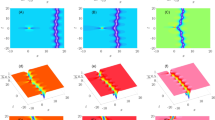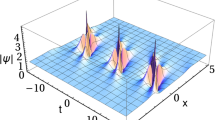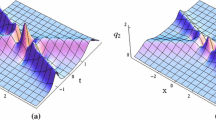Abstract
By means of the dressing technique, we build multipole solutions of the focusing Manakov system under a constant background. These solutions become degenerate when the poles of the dressing function merge. We find that with a special choice of the integration constants, such solutions describe the fusion or decay of the pulsing solitons—breathers—and their wave numbers and frequencies satisfy the typical resonance condition. We investigate the different cases of such resonance interactions.







Similar content being viewed by others
References
V. E. Zakharov, “Stability of periodic waves of finite amplitude on the surface of a deep fluid,” J. Appl. Mech. Tech. Phys., 9, 190–194 (1968).
N. Akhmediev and A. Ankiewicz, Dissipative Solitons, (Lecture Notes in Physics, Vol. 661), Springer, Berlin, Heidelberg (2005).
C. Sulem and P.-L. Sulem, The Nonlinear Shrodinger Equation. Self-Focusing and Wave Collapse, (Applied Mathematical Sciences, Vol. 139), Springer, New York (1999).
Y. S. Kivshar and G. P. Agrawal, Optical Solitons: From Fibers to Photonic Crystals, Academic Press, New York (2013).
M. Onorato, S. Residori, U. Bortolozzo, A. Montina, and F. Arecchi, “Rogue waves and their generating mechanisms in different physical contexts,” Phys. Rep., 528, 47–89 (2013).
C. Kharif, E. Pelinivosky, and A. Slunyaev, Rogue Waves in the Ocean, Advances in Geophysical and Environmetal Mechanics and Mathematics, Springer, Heidelberg (2009).
A. I. Maimistov and A. M. Basharov, Nonlinear Optical Waves, (Fundamental Theories of Physics, Vol. 104), Kluwer, Dordrecht (1999).
S. V. Manakov, “On the theory of two-dimensional stationary self-focusing of electromagnetic waves,” Sov. Phys. JETP, 38, 248–253 (1974).
V. I. Nayanov, Multifield Solitons [in Russian], Fizmatlit, Moscow (2006).
L.-C. Zhao and J. Liu, “Localized nonlinear waves in a two-mode nonlinear fiber,” J. Opt. Soc. Amer. B, 29, 3119–3127 (2012).
N. Vishnu Priya, M. Senthilvelan, and M. Lakshmanan, “Akhmediev breathers, Ma solitons, and general breathers from rogue waves: A case study in the Manakov system,” Phys. Rev. E, 88, 022918, 11 pp. (2013); arXiv: 1308.5565.
S. Chen and D. Mihalache, “Vector rogue waves in the Manakov system: diversity and compossibility,” J. Phys. A: Math. Theor., 48, 215202, 20 pp. (2015).
W.-J. Chen, S.-C. Chen, C. Liu, L.-C. Zhao, and N. Akhmediev, “Non-degenerate Kuznetsov– Ma solitons of Manakov equations and their physical spectra,” Phys. Rev. A, 105, 043526, 14 pp. (2022); arXiv: 2203.03999.
D. Kraus, G. Biondini, and G. Kovačič, “The focusing Manakov system with nonzero boundary conditions,” Nonlinearity, 28, 3101–3151 (2015).
B. Prinari, M. J. Ablowitz, and G. Biondini, “Inverse scattering transform for the vector nonlinear Shrödinger equation with nonvanishing boundary conditions,” J. Math. Phys., 47, 063508, 33 pp. (2006).
G. Biondini and D. Kraus, “Inverse scattering transorm for the defocusing Manakov system with nonzero boundary conditions,” SIAM J. Math. Anal., 47, 706–757 (2015).
A. A. Gelash and V. E. Zakharov, “Superregular solitonic solutions: a novel scenario for the nonlinear stage of modulation instability,” Nonlinearity, 27, R1–R39 (2014).
A. Y. Orlov, Soliton collapse in the integrable models (Preprint No. 221), Institute of Automation and Electrometry SB USSR Ac. Sci., Novosibirsk (1983).
G. E. Fal’kovich, M. D. Spector, and S. K. Turitsyn, “Destruction of stationary solutions and collapse in the nonlnear string equation,” Phys. Lett. A, 99, 271–274 (1983).
V. E. Zakharov and S. V. Manakov, “The theory of resonance interaction of wave packets in nonlinear media,” Sov. Phys. JETP, 42, 842–850 (1975).
I. V. Barashenkov, B. G. Getmanov, and V. E. Kovtun, “Integrable model with non-trivial interaction between sub- and superluminal solitons,” Phys. Lett. A, 128, 182–186 (1988).
I. V. Barashenkov and B. G. Getmanov, “The unified approach to integrable relativistic equations: Soliton solutions over nonvanishing backgrounds. II,” J. Math. Phys., 34, 3054–3072 (1993).
V. E. Zakharov and A. B. Shabat, “Integration of nonlinear equations of mathematical physics by the method of inverse scattering. II,” Funct. Anal. Appl., 13, 166–174 (1979).
A. A. Raskovalov and A. A. Gelash, “Resonant interactions of vector breathers,” JETP Lett., 115, 45–51 (2022).
E. A. Kuznetsov, “Solitons in a parametrically unstable plasma,” Sov. Phys. Dokl., 22, 507–508 (1977).
D. J. Kaup, “The three-wave interaction – a nondispersive phenomenon,” Stud. Appl. Math., 55, 9–44 (1976).
L. D. Faddeev and L. A. Takhtajan, Hamiltonian Methods in the Theory of Solitons, Springer, Berlin–Heidelberg (2007).
V. A. Arkad’ev, A. K. Pogrebkov, and M. K. Polivanov, “Application of inverse scattering method to singular solutions of nonlinear equations. I,” Theoret. and Math. Phys., 53, 1051–1062 (1982); “Application of inverse scattering method to singular solutions of nonlinear equations. II,” 54, 12–22, (1983); V. A. Arkad’ev, “Application of inverse scattering method to singular solutions of nonlinear equations. III,” 58, 24–32 (1984).
Acknowledgments
The authors are grateful to E. A. Kuznetsov for the helpful discussions.
Funding
This work was done in the framework of the Russian Science Foundation project No. 19-72-30028 https://rscf.ru/ project/ 19-72-30028/.
Author information
Authors and Affiliations
Corresponding author
Ethics declarations
The authors declare no conflicts of interest.
Additional information
Translated from Teoreticheskaya i Matematicheskaya Fizika, 2022, Vol. 213, pp. 418–436 https://doi.org/10.4213/tmf10357.
Appendix A. “Dressing” procedure for the defocusing Manakov system on a condensate background
It is instructive to give the result yielded by the “dressing” technique when it is used to construct solutions of the defocusing Manakov system on a condensate background.
The \(U\)–\(V\) pair for the defocusing Manakov system
The “dressing” function \(\chi=\Phi\Phi_0^{-1}\) satisfies the asymptotic conditions
We choose the one-pole solution in the form
As a result, the solution \(\psi_{1,2}(x,t)\) becomes
We use the parameterization
At \(C_1=0\), the denominator in (A.2) is sign-definite:
Thus, proceeding by analogy with the case of the vector focusing NLSE, we conclude that at arbitrary integration constants, solution (A.2) describes the fusion of a soliton with a singular excitation into a new singular excitation or, conversely, the decay of a singular solution into another singular solution and a soliton. It can be verified directly that both processes are resonance ones. That is, the frequencies and the wave numbers 1, 2, and 3 of solution (A.2) satisfy the resonance condition
Rights and permissions
About this article
Cite this article
Raskovalov, A.A., Gelash, A.A. Resonance interaction of breathers in the Manakov system. Theor Math Phys 213, 1669–1685 (2022). https://doi.org/10.1134/S0040577922120029
Received:
Revised:
Accepted:
Published:
Issue Date:
DOI: https://doi.org/10.1134/S0040577922120029




